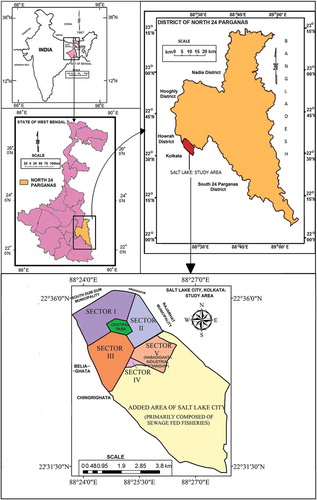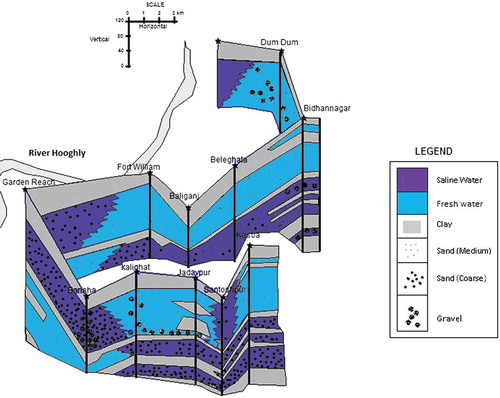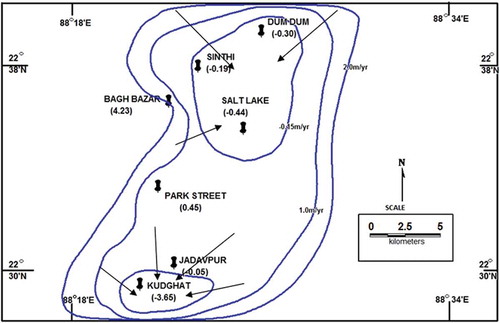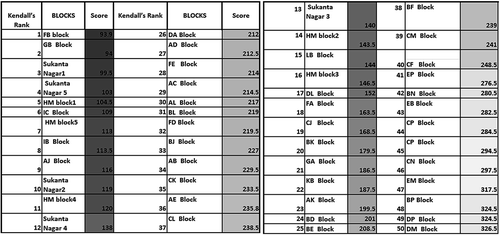ABSTRACT
The tenets of sustainable development are often ignored by growing cities in developing countries. Salt Lake City, located on the eastern fringes of Kolkata, despite being a planned township, has failed to manage its water resources in a sustainable way. Results from the study show that the water supplied at the households is hard in nature, saline, and replete with dissolved solids. The problem is further aggravated due to over-extraction of groundwater resources, resulting in an intense fall of the groundwater level in the area. This paper attempts to suggest measures for sustainable water resource management, with particular emphasis on rainwater harvesting.
Editor D. Koutsoyiannis Associate editor A. Efstratiadis
1 Introduction
Water is an indispensable natural resource, sustaining human life on Earth. However, extensive technological development coupled with increasing population growth have led to an increase in the water demand and this, in turn, has led to qualitative and quantitative deterioration of water resources on a global scale. Due to this, the world is in such a situation that the proportional availability of water with respect to human needs is nothing more than a “fairy tale”.
With many of the world’s megacities under water scarcity, the issue of sustainable management has currently become a cause of global concern (Mund Citation2010). Therefore, the need for judicious management of water is imperative considering the impending urban water crisis in both developed and developing countries, wherein the available reserves of clean water are less than the demand of the area (Jain Citation2014).
To escalate this situation, estimates have projected that the burden of urban population by 2050 will be so high in developing countries that providing access to reliable, sustainable and affordable means of water supply service will be difficult (World Bank Citation2016). In developing countries such as India, 90% of the urban population has access to drinking water, although this water is often not reliable or safe enough for ingestion. Therefore, continuous distribution of treated water is difficult in most of the states and water supply deficiencies crop up. To end the battle between demands of citizens and supply of water, public and privately owned enterprises try to import treated water and supply it against a decided tariff. Examples of such situations exist in the Indian cities of Delhi, Nagpur, Jamshedpur and parts of Haldia, to name a few. Yet, in the present situation, where urban centres are growing at a greater distance from water resources, importing water is very expensive; thus, it cannot be a viable solution. Under this premise, scientists apprehend that by 2050 the rate of growth of the population and the total amount of groundwater available in India will be reaching a critical point, beyond which supporting the people with water will not be possible (Kallaugher Citation2009, Tembhekar Citation2016).
Hence, alternative, low-cost approaches need to be taken up, so as to meet the water demands of the increasing population instead of relying only on water imports (PACS Programme Citation2001-08, Abdulla and Al- Shareef Citation2006, Ibrahim Citation2009). A promising solution for Indian cities is rainwater harvesting, i.e. tapping the available rainwater during the rainy season and adding it to the available urban water supply. The potential benefits of such technologies have been widely discussed in the literature (e.g. Rozos and Makropoulos Citation2012). So far, rainwater harvesting systems have been successfully developed in several areas worldwide (Taiwan, Singapore, Thailand, Berlin, Bangladesh), as well as in 11 states of India (Kerala, Tamil Nadu, Orissa, Punjab, etc.).
In this research work, Salt Lake City, West Bengal, has been chosen to depict the impacts of urbanization on its water resource and also to suggest measures for achieving sustainable water resources management, through rainwater harvesting. Developed far away from the available water resources, this township has suffered from malignant water deficit problems. Today, domestic water needs are met by over-exploiting groundwater reserves and mixing it with surface water supplied by the municipality, due to the shortage in funds with regard to water import over long distances. The situation has become more complex, since the Gravity Recovery and Climate Experiment (GRACE) satellites of NASA have revealed that there has been a systematic fall in the groundwater table within Salt Lake due to the concretization of roads and pathways, which prevents recharging of the aquifers during the rains.
Based on the outcomes of the present study, elaborated during August to October 2014, this article aims to assess the water management strategies implemented in Salt Lake City, with the objective of not only preventing the depletion and degradation of the dwindling resources, but also developing them in view of future requirements.
In this respect, firstly the impact of continuous extraction and utilization of groundwater in Salt Lake City, and its impact on the water level have been evaluated, in order to understand the effect of continuous pumping on the groundwater table. Secondly, the quality of water supplied at the households in this township has been tested so as to understand how far this water is suitable for being used as drinking water. Thirdly, an attempt has been made to envisage whether the prospect of water resource management through rainwater harvesting can help to improve the availability of water and at the same time maintain its sustainability in the reclaimed marshlands of Salt Lake City.
2 Study area
2.1 Brief outline of the study area
Built in the late 1900s, Salt Lake City, through eastward expansion of Kolkata, India, became the first reclaimed satellite township in West Bengal. Governed by the Bidhannagar Municipality, Salt Lake City, also known as Bidhannagar, covers an area of 12.35 km2 and lies between latitudes 22°33′5.55″N–22°36′10.44″N and longitudes 88°23′42.47″E–88°25′5.10″E, as shown in .
In 1953, late Dr B.C. Roy, then Chief Minister of West Bengal, invited a Dutch engineering committee, the NEDECO, to survey the Salt Water Lakes area. Subsequently, 70.29 ha of wetlands were occupied by the Government for extension of the northern regions of Salt Lake in 1956. The Salt Lake area was formally inaugurated in 1958 (Chattopadhay Citation1990). Salt Lake City was built to ease the pressure of migrating people on Kolkata. In order to accommodate this growing population and also to ease the pressure on land in the city proper, eastward expansion of Kolkata was carried out by filling up large tracts of wetlands in the eastern fringe of the city. However, the outcome of these developments was not compatible with the environmental needs.
Initially, the township was developed in “sectors” in which plots were categorically divided into residential, commercial, institutional and industrial, keeping in mind an average population of 20 000 people (Bhunia Citation1992, Toškovic Citation2008). However, due to large-scale urban expansion, the population has increased over the years and the present population of Salt Lake is 215 514 inhabitants, according to the Census of India (Citation2011).
Salt Lake Township has a hospitable climate for human habitation. The mean winter temperature is around 22.5°C, which decreases to a minimum of 10°C in the months of December–January. The mean temperature in summer is 29.2°C, increasing to a maximum of 40°C in April. The normal annual rainfall is around 1600 mm (KMC (Kolkata Municipal Corporation) Citation2014).
The soil comprises a marshy terrain with clay of very poor quality. To make this reclaimed wetland suitable for building, ground improvement through the dumping of white sand followed by compaction was adopted (). Hence, the peculiarity of the soil profile of Salt Lake is that the sandy topsoil is of good quality, but the clay layer immediately beneath is of extremely poor quality (Bhattacharya Citation2008). The layer closest to the surface is broadly composed of clay all over the area at large. Right below it, at about 15–35 m b.g.l. (below ground level), lies the freshwater aquifer layer, below which lies another thin layer of clay. Adjoining the latter clayey layer, there is another aquifer at a depth of around 60–137.5 m b.g.l. (Bhattacharya Citation2008). Below that lies a large zone of completely saline water, separated from the freshwater layer above by a clayey layer, as shown in the hydro-geological framework of the region.
2.2 Overview of current water resources management practices
Salt Lake City has depended on the aquifers existing under the land surface for the supply of water since the initiation of the satellite town. Till the late 1990s the entire water supply was dependent on the groundwater resource of the area. Over the years, with the increase in population and water requirements, the water supply has begun to include both treated surface water from the so-called Talla Reservoir as well as from groundwater. The groundwater is still being extracted through heavy-duty tube wells from a depth of 170–200 m within the confined aquifers. This water from the aquifers is pumped intensively, leading to discharge rates that vary between 91.0 and 113.75 m3/h, operating for 10 hours each day. But the rate of extraction is so high that the groundwater table has been lowered and continuous extraction leaves no time for its renewal. The treated surface water is sent to the individual overhead reservoirs at Salt Lake from Talla Reservoir, located in North Kolkata. For the purpose of distribution there are, at present, 16 Water Tower Zones with 15 overhead tanks, each of capacity 567.5 m3. Here, both water resources, i.e. groundwater and surface water, are mixed and transferred as potable water through the water distribution network. The Bidhannagar Municipality supplies a daily average of 0.17 m3 of water to each household every day. In Salt Lake City, there exist no surface water resources from which water imports might be possible. Further, groundwater pumping at individual levels is illegal. It is only the authorities in charge who have complete control over groundwater extraction. Hence, in case of any emergencies, the residents have to request the municipality by means of an application to provide them with vehicular tankers. These tankers are also government owned, and can only provide a maximum of 0.4 m3 for just a day (Bidhannagar Municipality Citation2014). No private vendors or private companies supplying water are allowed to operate within the boundaries of Salt Lake City. Thus, alternative modes of acquiring drinking water supply are unavailable, unless water is bought by the municipality, recycled from the grey water or collected through rainwater harvesting. Unfortunately, recycling of grey water and rainwater harvesting are not yet done in the area.
The grey and sewage waters of the households in Salt Lake are disposed off through separate underground pipelines that carry the used water in both grey and black forms through the combined sewerage network into the surrounding canals, which ultimately drain into the East Kolkata Wetlands, where sewage-fed pisciculture is practised. This does not lead to recharge due to a number of factors. Firstly, these wetlands are about 3 m deep and, once sewage water fills up them up, the stagnant water leads to sludge deposition at the bed. This prevents effective percolation and substantial recharge making occasional dredging essential. However, dredging is an expensive task; therefore it becomes difficult for the owners of the wetlands to bear the cost on a regular basis, and thus it is often not done. Secondly, these wetlands are emptied each month or, at times, even after a few weeks, depending upon the BOD (biological oxygen demand) levels that are required for practicing pisciculture. This again makes adequate recharging very difficult. Thirdly, Salt Lake has a very shallow unconfined aquifer, which is close to the surface and highly contaminated; thus, groundwater is drawn from deep confined aquifers which harbour cleaner water. So, even if negligible recharge does take place, it will be in a constant state of flux and will not reach the confined aquifers, thereby retarding its replenishment. The only option is artificial recharge of the confined aquifer. But this is not possible as it is extremely vulnerable to human interference.
Except for artificial recharge, recycling the grey water might be another option for this township, although, when compared to rainwater harvesting, it is much more expensive because recycling the water would mean setting up a grey water treatment plant of around 90 922 m3/d to provide a continuous supply to the residents. This would cost about 49 crore rupees (approx. US$7 198 100) at the time of installation, with additional charges each month for maintaining it. Of course, natural treatment of the wastewater by pisciculture is already being done in the East Kolkata Wetlands, which could be channelled back to the households to supplement the existing supply. But that would require further treatment in smaller satellite wastewater treatment plants before reaching the households, which is also a costly venture. With regard to rainwater harvesting, the township has the potential to store considerable amounts of rainwater, as it normally receives around 1600 mm of rainfall annually, and building structures for storing the same at the household level is cheap and a more viable option in the present situation. Hence, implementing rainwater harvesting in the area will help to prevent extraction of groundwater in certain seasons of the year, so that the groundwater has time to be replenished.
3 Technical issues under study and associated methodology
The technical issues that have been investigated in this study include: (a) evaluation of the impact of continuous extraction of groundwater on the groundwater table in the area; (b) assessment of the quality of the water supplied to households by the local municipality, in contrast to quality of rainwater, samples of which were collected between August and October 2014; and (c) appraisal of the possibility of implementing rainwater harvesting in Salt Lake City along with the establishment of efficient strategies, in order to achieve sustainable development of the water supply sector. Herein is briefly presented the methodology that was adopted for each individual issue, while the outcomes of the three analyses are discussed in Section 5.
3.1 Evaluation of impacts of continuous pumping on the groundwater table
The impact of continuous extraction of groundwater on the confined groundwater table was done by evaluating static water level data within the confined aquifers, collected from the Central Groundwater Board (CGWB) for a period of 30 years. Since extraction depends on the domestic water demand, it has also been shown that, over a period of 20 years, the utilization of water has changed with an increase in population by estimating the Pearson’s correlation coefficient of the region against the static water level.
3.2 Assessment of water quality supplied by the municipality vs rainwater quality
Maintaining the water quality is essential for achieving sustainable water resources management. For this purpose, several samples of potable water have been tested for parameters such as pH, TDS (total dissolved solids), salinity, sodium, potassium, nitrate, chlorides and hardness, to evaluate whether or not this can be utilized as drinking water. The first three parameters were tested via the PCS Testr-35, which is a digital meter, while the hardness test was done via a titration system.
Similarly, a number of samples of rainwater were collected during August–October 2014 and were evaluated against the same parameters. Every sample was compared to the drinking water standards, as stated by the Bureau of Indian Standards (BIS). Next, comparisons of the quality tests of rainwater and municipal water supply were developed by employing the Kendall ranking method:
where n is the number of parameters, Rij is the rank of the ith parameter over the jth area, and Ij is the composite index of constituents of water (Mahmood Citation2008).
The samples were ranked according to the amount of the different types of available constituents, where rank one was given to those samples that have the greatest individual values for each parameter, while higher ranks were given to the succeeding lower values. These ranks were then summed up row-wise to obtain the cumulative scores, after which the ones with the lowest score were arranged and ranked once again, with Rank 1 going to the one with the lowest score, while others got higher ranks. This determines that the lower the rank the purer the sample and vice versa. This depicts not only the places plagued by deteriorated municipal water quality, but also reaffirms the purity of rainwater, making the implementation of rainwater harvesting a conducive plan in the township.
3.3 Appraisal of the use of rainwater harvesting and the establishment of efficient strategies to achieve sustainable development
Rainwater harvesting is the easiest means of utilizing an alternative water source. The need for collecting rainwater immediately rises in cases of localities receiving adequate amounts of rainfall, while at the same time suffering from a rapidly deteriorating water supply system. But the possibilities, in theory, and the application, in reality, are two completely different aspects. In fact, no matter how feasible rainwater harvesting maybe, this practice may not be supported by the masses. To avoid this situation, questionnaire surveys have been conducted, where 200 respondents from 200 different households were selected on the basis of random sampling, so as to develop a clear idea regarding their perception and acceptance of the implementation of rainwater harvesting techniques in the township of Salt Lake City.
Ridit scores reflect the probability of a particular category, as found in the reference dataset. From such a dataset a “ridit” score is assigned for every category. This score is the percentile rank of one item in the data and is equal to the number of items in all lower categories plus one-half the number of items in the subject category, all divided by the sample size. After the ridit scores for each category have been determined, they are taken as values of a dependent variable for the other (comparison) groups and the normal distribution family of statistics is applied. For reasonable sample sizes, the mean ridit scores calculated in this way will be approximately normal (Flora Jr Citation1974, Panda and Sreekumar Citation2012). For the study, the reference dataset has been obtained from a questionnaire survey, where for m items the responses have been subjected to the ridit calculation. In this procedure, weights are given to response categories, which are arranged with the help of the five-point Likert scale, from the highest to the lowest favoured.
Further, the ridit result is subjected to the Kruskal-Wallis expression (Kruskal and Wallis Citation1952):
where ρi is the mean ridit, t is the sum of the ranks assigned, and m is the number of degrees of freedom. If the Kruskal-Wallis (W) test depicts that the relationships among the confidence intervals of ρ are found to be significantly greater than a Χ2 distribution with m − 1 degrees of freedom, each of the parameters becomes equally significant (Panda and Sreekumar Citation2012). This methodology is required to depict the priorities of the people with regard to the use of water and alternative sources (in this case, rainwater harvesting).
4 Results
4.1 Status of groundwater table due to continuous groundwater extraction
The daily extraction of groundwater, at the rate of about 15 000 m3/d, by the Bidhannagar Municipality, has led to systematic decline of the groundwater table (). With the increasing population, in the last 20 years the extraction has increased to a position in which the aquifers have failed to recharge themselves considerably. To depict this situation, the correlation coefficient method was used, where the population of the township was recorded as the independent variable, while the drop in static water level was considered to be the dependent variable (). With a population size of about 10 000 inhabitants in 1991, the static water level of the confined aquifer was at 9.21 m b.g.l., which gradually changed to 10.77 m when the population had increased to about 165 000 in 2001. Further, in 2011, when the population had risen to about 215 000, the groundwater level fell to 15.93 m. This shows that the water level decline is directly related to population increase and that there is a significant positive correlation between the two variables (r = 0.935).
Figure 3. Groundwater level over a period of 30 years (1983–2013).
Central Ground Water Board (1983–2013).
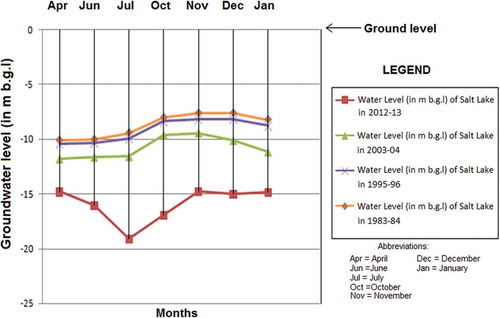
Figure 4. Correlation between population and groundwater level (in m b.g.l.) over a period of 20 years.

Since the groundwater is under daily stress, it is feared that in the near future the aquifers in the area will run completely dry (Basu and Ganguly Citation2012). If the confined freshwater aquifer runs dry, it will lead to the ingress of saline water from the saline aquifers further below. In such a situation, the impurities and number of salts are bound to increase. Therefore, an analysis of the groundwater has been conducted to find out its present quality (). The results state that the groundwater is highly saline (507 mg/L), with a large quantity of total dissolved solids (TDS) up to 746 mg/L, while the quantity of iron is beyond the permissible limit of the WHO and the BIS standards, i.e. 0.31 mg/L (WHO (World Health Organization) Citation2011). The values above the permissible limit have been marked in bold . This makes purification essential, since saline ingress due to over-extraction is not only polluting the fresh water aquifers but also reducing the groundwater level over the years, and further extraction may cause even more severe impacts on the sustainability of groundwater resources.
Table 1. Results of groundwater quality tests. Figures in bold denote values exceeding the permissible limits.
Another interesting consequence of over-extraction of groundwater is the evidence of land subsidence in the area, given that land is subsiding in those regions where highest activity or population density exists. Since groundwater was the sole source of drinking water until recent years, there has been a decrease in the pore water pressure of the aquifer (). According to Bhattacharya (Citation2008), areas in Salt Lake such as FC Block in Sector III, Ultadanga, Nicco Park and Karunamoyee are sinking at the rate of 20.5, 18.2, 12.8 and 10.6 mm/year, respectively, with a corresponding drop in the piezometric level of 9.48, 8.91, 5.93 and 4.89 m, respectively. This shows a positive correlation where with the greatest drop in piezometric level in the confined aquifer there is an equally greater fall in the land surface. For example, in the case of FC Block, there is a 20.5 mm/year rate of land subsidence for a 9.48 m piezometric level fall. Such dropping will continue over different parts of Salt Lake if extraction does not stop immediately (Bhattacharya Citation2008).
Figure 5. Subsidence of land (in mm/year) with drop in piezometric level (in cm/year).
Bhattacharya (Citation2008).
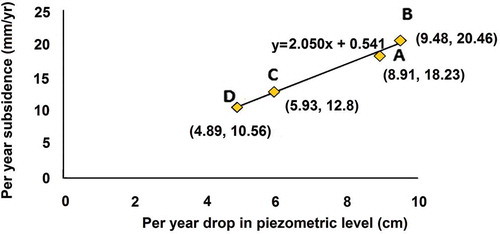
An example of the fall in the water table in the deep confined aquifers is given in , based on data collected by CGWB over a 10-year period (2002–2012). In , isolines depict the zones with a particular rate of piezometric drop, while the arrows show the direction of water pull. Thus, it can be seen that there has been an annual fall of 0.44 m/year in the piezometric levels in Salt Lake City. This is the lowest value in the northern part of the map, while the surrounding areas, in the same section, have greater values. Hence, the pull is towards the township. It may also be inferred that, if recharge occurs in areas such as Dum Dum and Sinthi, it will ultimately flow down to the aquifers beneath the township, helping it to recover. Another dip is towards Kudghat, which faces a similar situation to Salt Lake. Thus, the best alternative to prevent a greater drop in the water table is to harvest rainwater.
4.2 Quality testing of rainwater and municipal water
Fifty (50) drinking water samples were collected from households across five sectors of Salt Lake and tested for pH, TDS, salinity, chlorides, hardness, sodium, potassium, nitrates, etc. In addition, as mentioned before, 15 rainwater samples were also tested on the same parameters using the same method (). To get a better understanding about each of the 50 municipal water samples and the 15 rainwater samples, colours ranging from red, yellow to green are used to depict the highest to the lowest concentrations, while the samples exceeding the permissible limits are marked in bold (). The results show that almost 60% of drinking water samples deviated from the purity standards of both the Indian and World Health Organization standards, thus making them unsuitable at various levels for intake. In contrast, the tests for rainwater conclude that at every level the rainwater constituents are within the permissible limits, making it pure enough for human use.
Table 2. Results of rainwater quality tests. Figures in bold indicate values exceeding prescribed limits of WHO.
Table 3. Quality of drinking water supplied to households by Bidhannagar Municipality. Figures in bold exceed prescribed limits of WHO.
Based on the test results, the areas with impure drinking water supply were identified and mapped ( and ). The maps suggest that Sector III is in the worst state. All tested parameters seem to have the highest score in this sector; thus, the drinking water supply needs immediate attention. Not only does this sector require the development of rainwater harvesting systems, but it also requires a long-term solution for grey water recycling. Sectors IV, II, I and V also follow suit with regard to deteriorating water quality. Taking all these inferences into account, it can be stated that the presence of salts in the water increases when more groundwater and less surface water is supplied, which is a clear example of over-extraction of groundwater. According to the hydro-geological map, the freshwater aquifer zone exists closest to surface resources, while right below lies the saline water zone. Therefore, once the aquifers run dry, the dearth of water is replaced by saline intrusion, making the potable water saline.
Figure 7. Salinity, hardness and chloride levels (mg/L) in the municipal water supply.
Primary Data (2014).
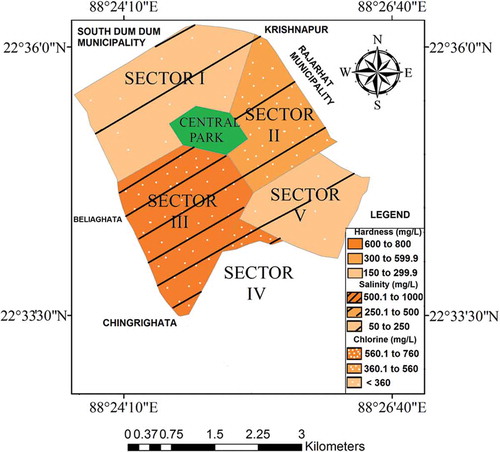
Furthermore, for the municipal water samples, the individual values were then ranked according to Kendall’s ranking method () and accordingly the worst affected sectors were identified. The ranks show that Sectors III and IV need more attention than Sectors I, II and V. Consequently, the need for rainwater harvesting is high in almost all the sectors, on average.
4.3 Implementation of rainwater harvesting as a remedial policy measure to aid water resources management
The above results indicate that water resources management in Salt Lake City so far has been quite unsustainable. As mentioned earlier, rainwater harvesting is the most viable option for tackling this problem. But the possibility of implementing this measure depends to a large extent on the perception of the local community about implementing the idea of rainwater harvesting at the household level. Therefore, a survey was conducted on a sample size of 200 households across the township to understand their perception about rainwater harvesting and possible ways to implement it. A number of issues were given to the respondents and they were asked to select the most important of them, which according to their perceptions could be considered essential for setting up rainwater harvesting at the household level. These responses were subjected to a Ridit analysis, as given in and . The Ridit responses show that out of all issues considered in the survey, the most crucial was Bidhannagar Municipality’s responsibility in bearing the monetary burden of installing rainwater harvesting tanks for the individual households.
A direct sorting of mean ridit scores in terms of probability of being in higher propensity gives the priority list, as seen in .
5 Design of a rooftop rainwater harvesting system
Rainwater harvesting is an idea that people generally welcome. As shown through the perception study, the Municipality can sponsor the setting-up of round PVC tanks instead of concrete reservoirs on the roofs. In this context, the tank will be built on the roof, wherein a rainwater collecting shade with a rainwater down-comer (RWDC) will be erected during the rainy season. This roof shade will be made of fibre-reinforced plastic (FRP).
As observed from the Dum Dum Observatory records, during the rainy season Salt Lake receives around 120–160 mm of rainfall per day, on average (Indian Meteorological Department (IMD) Citation2015). Hence, if a shade of 5 × 5 m in plan area is built, it would receive about 3750 L of rainwater. Taking this into consideration, three round PVC tanks, each having capacity of 3000 L, could be placed on each roof, and the RWDCs, connected to gutters, could collect a minimum of 9000 L of rainwater per day. A typical tank could have a diameter of approximately 59.0 inches, a height of around 79.5 inches, and a manhole diameter of around 15.7 inches, as given in . The financial costs for the total set-up are provided in . Considering the various costs, including labour and maintenance, installing the PVC tanks requires an initial investment of approximately 70 000 INR (US$1027).
Table 4. Perspectives of residents on the existing situation, and their views on supplementing the existing water supply with rainwater harvesting.
Table 5. Ridit scores. SD: standard deviation; LB: lower boundary; UB: upper boundary.
Table 6. Sequence of mean ridit sorting.
Table 7. Estimated cost of constructing PVC tanks for rooftop rainwater harvesting.
Figure 10. The design envisaged for a rooftop rainwater harvesting system.
Pinterest Inc. - Rainwater harvesting 2015; the Tank Source-Round Rainwater Tanks 2015; and authors’ own elaboration.
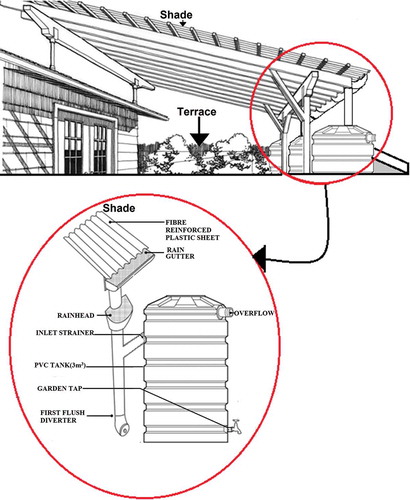
Using these PVC tanks, rainwater harvesting can be done at the individual level, i.e. at the rooftops. The harvested water may be conducted into the homes to be used for all purposes except for drinking. Households in the township have about 10–15 members, with an average daily water demand of 0.17 m3 per capita, three PVC tanks of total capacity of 9 m3 will be able to significantly reduce the water demands from the municipality. Hence, without the need for expensive treatment of wastewater, people can benefit from such harvesting systems using freely available rainwater.
Obviously, the implementation of this project by the local authorities, at such a large scale, is not an easy task. To encourage residents, the administrative authority of the township could offer some exemption in the annual house tax that is levied in the township. This would also reduce the over-extraction of groundwater and allow the aquifers to replenish themselves. In this context, an upper threshold for the extracted groundwater may also be enforced, where ~15 000 m3/day of extraction can be stopped during the rainy season. This quantity would be replaced by rainwater stored in the overhead reservoirs. With the help of this implementation the aquifers will have time to replenish themselves.
6 Conclusions
The sustainability of urban water supply systems is in a precarious condition in the 21st century. With increasing urban growth, technological improvement and all-round development in the megacities of the developed and developing world, this vital resource is gradually shrinking in quantity, while demand keeps on increasing. To avoid this crisis in the urban environment, an immediate shift of the current water management strategy is mandatory, in which rainwater harvesting can play a key role.
In the study area of Salt Lake City, Kolkata, there is continual extraction of water from groundwater reserves. This has led to aquifer depletion, water scarcity and even land subsidence. Therefore, an immediate cost-effective measure is essential to tap potential reserves before further deterioration affects this township. As a remedy, a number of options are available, such as grey water recycling, buying more surface water from the Kolkata Municipal Corporation and practicing rainwater harvesting. As explained, grey and wastewater recycling is not a very satisfactory solution, as the wastewater is not segregated into black and grey water and is discharged in a combined form. Furthermore, the installation of a large-scale greywater treatment plant would require a huge investment cost; this would further require a large distribution network, which would also be very expensive, thus resulting in the imposition of additional taxes on the inhabitants. Furthermore, the “fund crunch” of the Bidhannagar Municipality has prevented them from buying more water from the Kolkata Municipal Corporation, or setting up grey water recycling plants for the residents. Thus, in order to protect the aquifers of Salt Lake City, the most viable option is rainwater harvesting.
The rainwater harvesting mechanism is not an alien policy, since the socio-economic and environmental conditions are conducive for its implementation. Moreover, the water quality tests indicate that the rainwater is purer than the mixed drinking water provided at the household level. Hence, if an initiative is taken by the municipality, declaring the implementation of rainwater harvesting structures on the roofs of all buildings, it will be possible to restrict the over-extraction of groundwater. This can be made feasible by setting up PVC tanks on rooftops.
Thanks to this application, the authorities or even the local communities will be able to utilize freely available rainwater and supplement the daily supply of surface water with it. Hence, there exist strong arguments for its success, and in the long run this might act as a paradigm for future megacity development projects in the world.
Disclosure statement
No potential conflict of interest was reported by the authors.
References
- Abdulla, F.A. and Al- Shareef, W.A., 2006. Assessment of rainwater roof harvesting systems for household water supply in Jordan. Integrated Urban Water Resources Management NATO Security Through Science Series, 291–300. doi:10.1007/1-4020-4685-5_30
- Basu, J. and Ganguly, B., 2012. High and Dry. The Telegraph. January 22 http://www.telegraphindia.com/1120122/jsp/calcutta/story_15037639.jsp#.VVmyiuMSXK4 [Accessed 10 April 2015].
- Bhattacharya, A.K., 2008. Hydrogeology and land subsidence in Salt Lake City, Kolkata, India. Electronic Journal of Geotechnical Engineering, 13, 1–14.
- Bhunia, A.K., 1992. Economics of water supply to Bidhannagar: calcutta water supply- techno economic options. The Indian Association of Geohydrologists, Kolkata, West Bengal, 14–17 October.
- Bidhannagar Municipality, 2014. History http://www.bidhannagarmunicipality.org/history [Accessed 10 April 2015].
- Census of India, 2011. DDW_PCA1911_2011_MDDS with UI.xlsx [online]. Primary Census Abstract 1911 to 2011. Available from: www.censusindia.gov.in/pca/…/DDW_PCA1911_2011_MDDS%20with%20UI.xlsx [Accessed 10 April 2015].
- Chattopadhay, H., 1990. From Marshland to Township East of Calcutta. Calcutta: Baggchi & Company.
- Flora Jr, J.D., 1974. A note on ridit analysis. Technical report.
- Ibrahim, M.B., 2009. Rainwater harvesting for urban areas: a success story from Gadarif City in Central Sudan. Water Resources Management, 23, 2727–2736. doi:10.1007/s11269-009-9405-6
- Indian Meteorological Department (IMD) 2015. Current weather. http://www.imdkolkata.gov.in/currentwx.php?s_1=1; [ Accessed 12 October 2016.]
- Jain, A., 2014. Complacency: compounding the Urban Water Crisis. Indian Journal of Public Administration, Lx(1), 105–116. Available from: www.iipa.org.in/New%20Folder/7-Anushri.pdf [Accessed 10 April 2015].
- Kallaugher, L., 2009. GRACE reveals ground water depletion in India [online]. Environmental Research Web. Available from: http://environmentalresearchweb.org/cws/article/news/40091 [Accessed 10 April 2015].
- KMC (Kolkata Municipal Corporation), 2014. District at a Glance. Ground Water Information Booklet [online]. Available from: http://cgwb.gov.in/District_Profile/WestBangal/Kolkata%20Municipal%20Corporation.pdf [Accessed 9 April 2015].
- Kruskal, W.H. and Wallis, W.A., 1952. Use of ranks in one-criterion variance analysis. Journal of the American Statistical Association, 47 (260), 583–621. doi:10.1080/01621459.1952.10483441
- Mahmood, A., 2008. Statistical Methods in Geographical Studies. New Delhi: Rajesh Publications.
- Mund, J.P., 2010. Capacities for Megacities Coping with Water Scarcity. World Water Week, Stockholm, UNWDPC. Available from: http://www.watergovernance.org/documents/WWW_PDF/2010/tuesday/T5/mund_Capacities_for_Megacities.pdf [Accessed 10 April 2015].
- PACS Programme, 2001-08. Drought in India: challenges and Initiatives. Consumer Co-ordination Council. http://www.cccindia.co/corecentre/Database/Docs/DocFiles/drought_india.pdf; [ Accessed 10 April 2015].
- Panda, R.K. and Sreekumar, 2012. Prioritizing issues in agribusiness using ridit analysis: an Indian perspective. World Journal of Agricultural Sciences, 8 (1), 80–88.
- Rozos, E. and Makropoulos, C., 2012. Assessing the combined benefits of water recycling technologies by modelling the total urban water cycle. Urban Water Journal, 9 (1), 1–10. doi:10.1080/1573062X.2011.630096
- Tembhekar, C., 2016. By 2050, you may have to live on imported water. Times of India, April 22. Available from: http://timesofindia.indiatimes.com/india/By-2050-you-may-have-to-live-on-imported-water/articleshow/51935321.cms [Accessed 10 October 2016].
- Toškovic, D., 2008. A Review On Salt Lake City, Kolkata*, India: master Planning And Realization. Available from: www.doiserbia.nb.rs/ft.aspx?id=1450-569X0818098T. 711. 434 (541. 23) [Accessed 14 October 2016].
- WHO (World Health Organization), 2011. Guidelines for drinking-water quality. Geneva: World Health Organization.
- World Bank, 2016. Urban water supply in India. World Bank. Available from: http://www.worldbank.org/en/news/feature/2011/09/22/urban-water-supply-india [Accessed 10 October 2016].

